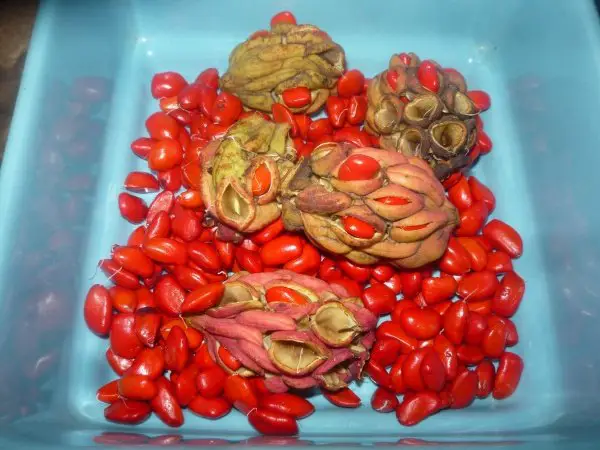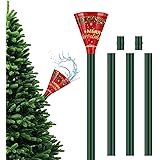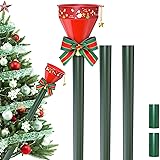Magnolia trees are renowned for their beautiful, fragrant flowers that bloom in spring and summer. However, once the flowers fade, they leave behind seed pods that litter the ground below the tree.
This leads many magnolia tree owners to wonder – are magnolia seed pods poisonous to humans?
An Overview of Magnolia Seed Pods
Magnolia seed pods are typically around 3-5 inches long and shaped like a cone or teardrop. They start out green but turn brown as they mature. Inside the pod are bright red seeds enveloped in a waxy red coating.
The seed pods form after the magnolia finishes flowering. The flowers leave behind a green cone that develops over summer into the mature seed pod. The pods then remained closed on the tree through fall and winter. They eventually open in spring to release the red seeds inside.
While magnolia trees are non-toxic, some people worry the seed pods may be poisonous to humans due to the bright coloration. So what’s the verdict?
Are Magnolia Seed Pods Poisonous?
The good news is magnolia seed pods are not poisonous to humans. Both the pod itself and the seeds inside are completely safe for human consumption.
In fact, the red seeds inside magnolia pods are edible with a slightly sweet, lemony taste. The red coating is mildly bitter but not toxic.
While not poisonous, the hard shells of mature pods and large seeds make the pods unpalatable for most people. However, magnolia seeds are used in some traditional Chinese medicine and cuisine.
So if magnolia pods litter your yard, you don’t need to worry about poisoning. But you also don’t need to rush to make them part of your next meal. The pods and seeds are non-toxic but not exactly tasty to humans.
Read More: About Can Led Light Replace Sunlight For Plants?
Reasons Magnolia Pods Are Thought To Be Poisonous
If magnolia seed pods aren’t actually poisonous, why do so many people think they are? There are a few reasons this misconception developed:
1. Bright Red Color
The vivid red coloration of the seeds and waxy coating inside magnolia pods grabs people’s attention. Brightly colored seeds and fruits in nature often signal toxicity as a warning, so it’s easy to assume magnolia seeds follow the same pattern. However, their red color simply attracts birds who then spread the seeds.
2. Resemblance to Poisonous Yew Seeds
Crushed magnolia seeds release a red dye that resembles a toxic substance produced by poisonous yew seeds. Yew is extremely toxic, so this likely added to suspicions about magnolia toxicity. However, magnolia does not contain the poisonous chemicals in yew.
3. Unpleasant Taste
Magnolia seeds and pods don’t taste very good. The bitter, waxy coating seems like nature’s way of discouraging consumption. However, the bad flavor is more for seed dispersal than due to poison. It prevents animals like humans from chewing up all the seeds so birds can spread them after eating pods.
4. Confusion With Other Magnolia Species
Some magnolia species like Southern magnolia have very large seed pods with pungent odors that seem suspicious. However, even these species are non-toxic, just unappetizing. There are no known magnolia tree species with poisonous seeds or pods.
So in summary, the red color, bad taste, and large size of magnolia pods led to misconceptions that they must be poisonous. But despite all these cues to avoid consumption, magnolia seeds pose no toxicity risk to humans.
Benefits and Uses of Magnolia Seed Pods
While magnolia pods aren’t poisonous, you may be wondering if they offer any benefits to humans when used properly. As it turns out, magnolia seeds do have some interesting uses, despite being unpalatable on their own. Here are a few ways magnolia pods can be beneficial:
Medicinal Uses
In Traditional Chinese Medicine, magnolia seed pods are used to treat a variety of ailments, included asthma, anxiety, and allergies. The seeds are believed to clear nasal congestion. They are also used for digestive complaints like bloating, gas, and nausea. More research is still needed to confirm the efficacy and safety of magnolia seed medicinal uses.
Magnolia Seed Oil
While too bitter to eat directly, magnolia seeds can be used to produce a pleasant-smelling oil. Magnolia seed oil is prized in cosmetics for its lightweight feel and ability to absorb quickly into skin and hair. Due to its high cost, magnolia oil is usually found in luxury beauty products.
Fragrant Incense
Dried magnolia pods can be used to create fragrant incense. Simply throw a few seed pods onto lit charcoals and let them smolder. The smoke produces a rich, woody aroma from the magnolia’s essential oils. Just take care to avoid inhaling too much smoke, which can cause respiratory irritation.
Unique Texture in Crafts
The large, distinctive magnolia pods can be incorporated into flower arrangements, wreaths, and other craft projects. Their unique, sculptural shapes add interesting textures. Spray painting dried pods metallic colors like gold and silver allows for even more decorative possibilities.
Overall, while magnolia pods aren’t widely consumed, they have some nifty applications thanks to their large size, fragrance, and oil content. So don’t send those fallen pods straight to the trash! With a little creativity, they can become useful items around your home.
Are Any Parts of a Magnolia Tree Toxic?
While magnolia seed pods are perfectly safe, are there any parts of a magnolia tree that are poisonous?
Fortunately, most parts of a magnolia tree are non-toxic to humans. This includes:
- Leaves
- Flowers
- Bark
- Sap
- Stems
- Roots
The bark and roots, while not poisonous, are very bitter. Large doses may cause stomach upset in some individuals.
Overall though, the entire magnolia tree is considered non-toxic and safe. The only exception is the unripened flower buds.
Caution With Unripened Magnolia Flower Buds
Immature, unopened magnolia flower buds can be mildly toxic, causing symptoms like digestive upset, confusion, and dilated pupils if consumed. However, toxicity is due to tannins in the buds that disappear as the flowers fully open.
Fully bloomed flowers, on the other hand, are completely edible with a faint lemony taste. Just avoid eating too many to prevent possible laxative effects from fiber overdose.
So while magnolia trees are non-toxic overall, stick to eating only the opened, mature flowers to be safe. The tastelessness of other parts also makes them unappealing anyway.
Are Magnolia Seed Pods Safe For Pets?
If magnolia seed pods won’t harm humans, what about risks to pets who may nibble on fallen pods in the yard?
The good news is magnolia pods do not appear toxic for dogs or cats. However, the large seeds may present a choking hazard.
Monitor pets when pods are on the ground and avoid letting them chew on the seeds. Contact your vet if you see signs of intestinal obstruction like appetite loss, vomiting, or lethargy after they’ve consumed seeds or pods.
Some pet owners report magnolia pods giving dogs mildly upset stomachs. It’s unclear if this is due to toxicity or simply irritation from the waxy coating on the seeds. Either way, it’s best to limit pets exposure to magnolia litter when possible.
In summary, while not dangerously poisonous, magnolia pods can trigger mild stomach upset in pets when consumed. Pick up fallen pods promptly to keep pets safe. And of course, keep both dogs and cats away from unripened flower buds, which are more problematic than the mature pods.
Read More: About How To Propagate Corn Plant
Frequently Asked Questions About Magnolia Seed Pod Safety
No, magnolia seed pods and the seeds inside are non-toxic to humans. While the red seeds may look suspicious, they are completely edible without poisonous effects.
No parts of a magnolia tree are dangerously toxic to humans. The flowers, leaves, bark, roots, and sap are all safe. Magnolia is non-toxic, apart from possible stomach upset from unripened buds.
Yes, the red seeds inside magnolia pods are edible. However, they have a bitter, waxy coating that makes them unpalatable to humans. Some cultures do consume magnolia seeds, but most people find them too unpleasant to eat.
Only mature, opened magnolia flowers are safe to eat. Unopened buds can cause toxicity effects like nausea, confusion, and dilated pupils due to high tannin content. Allow buds to fully bloom before consuming magnolia flowers.
The pods that fall from magnolia trees are seed pods that contain the mature seeds. They form after flowering finishes, turning from green to brown. While harmless, magnolia pods are fibrous and unappetizing.
Craft uses are the best option for fallen magnolia pods. Their interesting shapes and sizes provide nice textures in wreaths, arrangements, and other projects. Magnolia pods can also be dried and burned as fragrant incense.
Magnolia seeds can be used to produce magnolia seed oil, which is beneficial in cosmetics. Magnolia seeds also have some medicinal uses in Traditional Chinese Medicine, though these benefits are unproven. Aside from that, the seeds don’t have many uses.
Magnolia bark is not toxic, even in large amounts. However, the bark is extremely bitter and can potentially cause mild stomach upset if you consume a lot. It’s best to avoid eating magnolia bark. But in normal amounts, it poses no toxicity risks.
There are no common side effects of magnolia trees or their parts. On rare occasions, magnolia flowers, leaves, bark, etc may cause mild diarrhea or digestive upset if large amounts are eaten. However, magnolia is considered very safe overall.
The petals of fully bloomed magnolia flowers are edible and make a nice floral garnish. Remove the bitter green sepals at the flower base before eating. Avoid unopened buds, which have higher tannin levels that can cause toxicity effects if consumed.
No, magnolia seed pods are not poisonous to dogs. However, dogs should not be allowed to chew on or consume the large seeds, which pose a potential choking hazard or may cause mild stomach upset. Overall though, magnolia pods are not dangerously toxic for canine consumption.
The Takeaway: Enjoy Magnolias Safely
Magnolia trees produce seed pods that may seem suspicious but are completely non-toxic to humans and pets. So if magnolia litter bothers you for aesthetic reasons, rest assured it poses no poisoning risk.
That said, don’t expect magnolia pods or seeds to become a new superfood. The red seeds are edible but quite bitter. Mature pods are also unpalatable. While used medicinally in some cultures, no proven health benefits exist.
The good news is you can craft with fallen magnolia pods without worry. Just be sure to keep unripened buds away from pets and kids. Then relax and enjoy the beauty of your magnolia tree in full bloom, knowing it brings zero harm.
With their showy flowers and harmless seed pods, magnolia trees make a gorgeous, non-toxic addition to any landscape. Their beauty can be appreciated without any concerns of poisoning humans or animals. So sit back and savor their spectacular floral show as those giant blooms herald the arrival of spring.
Auto Amazon Links: No products found.
IPOOLTENG Christmas Tree Watering Funnel 3 Tube 1 Funnels 40 Inch - 3 Section Plastic Christmas Tree Funnel Waterer, Long Funnels for Watering Trees, Best Gifts for Your Parents to Water Tree
$15.53 (as of December 4, 2025 15:26 GMT +00:00 - More info- Product prices and availability are accurate as of the date/time indicated and are subject to change. Any price and availability information displayed on [relevant Amazon Site(s), as applicable] at the time of purchase will apply to the purchase of this product.
Christmas Tree Watering Funnel, Real Christmas Tree Water Long Funnel About 40 Inch, Trees Watering System for Water Indoor Outdoor
$15.99 (as of December 4, 2025 15:26 GMT +00:00 - More info- Product prices and availability are accurate as of the date/time indicated and are subject to change. Any price and availability information displayed on [relevant Amazon Site(s), as applicable] at the time of purchase will apply to the purchase of this product.
Christmas Tree Watering Funnel-39 Inch Adjustable 3-Section Long Funnel Spout Funnel Watering System Xmas Plant Watering Tool for Large Indoor Outdoor Plants
$14.59 (as of December 4, 2025 15:26 GMT +00:00 - More info- Product prices and availability are accurate as of the date/time indicated and are subject to change. Any price and availability information displayed on [relevant Amazon Site(s), as applicable] at the time of purchase will apply to the purchase of this product.
LANNEY 48.6 Inch Christmas Tree Watering Funnel, Extra Long Xmas Tree Waterer Spout with Metal Tube, Christmas Watering Device System Tool for Indoor and Outdoor Real Live Plant
$13.99 (as of December 4, 2025 15:26 GMT +00:00 - More info- Product prices and availability are accurate as of the date/time indicated and are subject to change. Any price and availability information displayed on [relevant Amazon Site(s), as applicable] at the time of purchase will apply to the purchase of this product.
Christmas Tree Watering System, 50 Inch Long Christmas Tree Watering Funnel Tool for Xmas Plant Watering Indoor Outdoor Large Plants
$16.99 (as of December 4, 2025 15:26 GMT +00:00 - More info- Product prices and availability are accurate as of the date/time indicated and are subject to change. Any price and availability information displayed on [relevant Amazon Site(s), as applicable] at the time of purchase will apply to the purchase of this product.
Snow Joe Premium Enviro Blend Ice Melt, Green-Coated Deicer Crystals, 50 lb - Safer Melter for Vegetation, Concrete & Metals w/ Anti-Corrosion Calcium Magnesium Acetate
$32.97 (as of December 5, 2025 17:01 GMT +00:00 - More info- Product prices and availability are accurate as of the date/time indicated and are subject to change. Any price and availability information displayed on [relevant Amazon Site(s), as applicable] at the time of purchase will apply to the purchase of this product.
Muddy Mat® Shown on TV Super Absorbent Microfiber Dog Door Mat for Muddy Paws, Non-Slip Washable Pet Rug, Quick Dry Chenille Entryway Carpet, Machine Washable Indoor Outdoor mat, Grey 30"x19"
$19.95 (as of December 5, 2025 17:01 GMT +00:00 - More info- Product prices and availability are accurate as of the date/time indicated and are subject to change. Any price and availability information displayed on [relevant Amazon Site(s), as applicable] at the time of purchase will apply to the purchase of this product.
Cuisinart 6.5" Cast Iron Smashed Burger Press, Round Flat Edge Grill Press for Crispy Smash Burgers, Burger Tool for Grill and Griddle Accessories, for BBQs and Tailgates
$24.99 (as of December 5, 2025 17:01 GMT +00:00 - More info- Product prices and availability are accurate as of the date/time indicated and are subject to change. Any price and availability information displayed on [relevant Amazon Site(s), as applicable] at the time of purchase will apply to the purchase of this product.
Zevo Flying Insect Trap Official Refill Cartridges - Fits Both Zevo Trap & MAX Indoor Fly Trap - Authentic Trap+Lock Technology to Catch Gnats, House & Fruit Flys (4 Official Refill Cartridges)
$13.47 (as of December 5, 2025 17:01 GMT +00:00 - More info- Product prices and availability are accurate as of the date/time indicated and are subject to change. Any price and availability information displayed on [relevant Amazon Site(s), as applicable] at the time of purchase will apply to the purchase of this product.
OLANLY Dog Door Mat for Muddy Paws 30x20, Absorbs Moisture and Dirt, Absorbent Non-Slip Washable Doormat, Quick Dry Chenille Mud Mat for Dogs, Entry Indoor Entryway Carpet for Inside Floor, Grey
$9.99 (as of December 5, 2025 17:01 GMT +00:00 - More info- Product prices and availability are accurate as of the date/time indicated and are subject to change. Any price and availability information displayed on [relevant Amazon Site(s), as applicable] at the time of purchase will apply to the purchase of this product.











